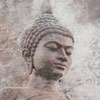On The Role Of Beauty In Reincarnation
 by Gina Ceraminara
by Gina Ceraminara
Beauty is not ordinarily regarded as the proper goal of a philosopher; nor is it usually considered to be of any practical concern to psychologists, doctors, ministers, or priests to help their patients or parishioners to become beautiful. As a quest and a purpose, beauty is commonly regarded as the trivial preoccupation of beauty salons and of women whose vanity outweighs the more real and more sober preoccupations of life.
And yet—if we carry still further to its logical conclusions the data of the Cayce files—we must arrive at the conviction that beauty is of far greater significance and importance, psychologically and spiritually, than we had thought; and that, indeed, philosophers, doctors; psychologists, ministers, and priests alike should be as much guided by beauty as an ultimate goal of all people as they are by concepts of adjustment, efficiency, health, happiness, morality, and of the Good Life.
If we accept the Cayce clairvoyance, we cannot help but conclude that Keats’ famous line: “Beauty is truth, truth beauty” can be better expressed, at the psychosomatic level, as: “Beauty is goodness, goodness beauty.” For we see again and again in the Cayce records that ugliness and deformity are the penalty of evil behavior, and that beauty, health, and symmetry are the reward of good.
The semanticist may, to be sure raise several important issues at this point. He may well point out, first of all, that beauty is a relative matter; and it is certainly true that different standards of beauty are to be found in different portions of the world. Extreme examples of the variability of human concepts of beauty are to be seen in the dish-like lower lips of the Ubangi women—a deformity which they deliberately create—and again in the tightly bound feet of the women of ancient China. But these are extreme and eccentric examples. Generally speaking, the differences between concepts of beauty are not so great as the similarities. In almost all cultures, health, energy, proportion, symmetry, and clarity of outline are the basic components of beauty, whatever minor variations there be on the theme—and even over race and culture lines outstanding beauty is recognizable by all people. In any case, the karmic balances would be fairly made as long as the individual in question was beautiful or ugly relative to the standards of the group in which he found himself—so that minor differences in the criteria of beauty would probably reflect the difference between racial archetypes and not appreciably modify the karmic equation.
The semanticist may point out next that “good” and “evil” are also relative matters; and here again, his point is well taken. Morals and customs differ startlingly in different eras and different portions of the world. But, by the Cayce and the reincarnationist view at least, goodness and evil in the last analysis transcend the relativity of custom and exist in a more cosmic, more universal sense than that usually attributed to them by moral systems. Goodness, by this view, is that which is loving, unitive, kind, and spiritually instigated; evil is that which is selfish, separative, cruel, and sensually instigated.
In the Cayce files we have the case of a contemporary woman the right side of whose face was paralyzed. Why? Because, Cayce said, she had misused her beauty in an unspeakably shameful manner when she was once a queen in Cambodia. Certainly the morals of ancient Cambodia must have differed in many respects from those of today; and beauty in that era might well have meant eyes of a slightly different slant and coloring of a slightly different hue than that in favor in modern Anglo-Saxon countries. But grossness and sensuality, and the selfishness that is almost inevitably associated with them are universals, found in all eras and all countries, and a paralyzed face is a paralyzed face: a deterrent to beauty no matter what the era or what the current fashions in beauty.
And so the general equivalence of beauty and spiritual virtue, over the arc of time, would seem to be a true equivalence, in spite of the relativity of cultures.
There is still another objection that can be raised to this equation. All of us have seen cases of inner goodness combined with outer beauty; we have seen cases where the outer ugliness was a clear reflection of the inner evil. But we have also seen cases where inner goodness was found combined with outer ugliness, and the converse where an unscrupulous or shallow character was clothed with great outer personal beauty. Moreover, we have seen ambiguous and misleading cases in the middle ground somewhere between those two poles.
There are several factors that can account for these apparent discrepancies. First, there is the subjective element: the limitations of the judge. He who is lacking in a trait cannot easily recognize its manifestations in another. He who is of lesser intelligence cannot possibly perceive the subtle gradations of the intelligence that is above him; he who is of lesser spiritual goodness cannot perceive the delicate nuances of spiritual goodness and sensitivity beyond his own. Moreover, he who is lacking in wide and deep experience of men makes generalizations on an inadequate basis. A person who has had one unhappy experience with a red-haired woman, and several happy experiences with strong-jawed men, may thereafter have a strong negative judgment against all red-haired women and strong favorable predisposition to all strong-jawed men. Racial and national biases may make him blind to the structural beauty in the faces of persons of other racial or national origins. These limitations and biases are involved in any human estimate of another human being.
And so what sometimes seems to an observer to be a contradiction between inner and outer may not necessarily be a true contradiction; it may merely be lack of fine enough perceptions on his part to see the correspondence. We can be misled by a smooth symmetrical appearance much in the same way that we can be misled by a smoothly written contract. It is only later, when the lawyer points out to us the phrases in fine print, that we clearly see the true heartlessness of the document. Similarly, sad and perhaps expensive personal experience may lead us finally to see the minute lineaments and proportions which clearly spell treachery or selfishness in the face of what we had for a long time considered to be a completely beautiful person. And, on the other hand, it may require the combined influences of art and of life experience to make some people aware at long last of beauty in faces (especially those of other races) which at first seemed nondescript or ugly.
A second element in this whole problem of apparent discrepancy is the element of parallel causation—by which we mean that a beautiful body can be the result (according to the Cayce material, at least) of two levels of causation: the spiritual and the physical. The person who directs all his thought and energy to the creation of physical health, symmetry, and beauty will be rewarded sooner or later by a healthy, symmetrical, beautiful body; but it can well be an “empty” body in the sense that a beautiful store-window mannequin is empty. An individual of this type would seem soulless—as do, in fact, many extremely beautiful men and women. Spiritual content and intent is lacking; and persons of this type can probably find their most educative experiences in life through the loss of their health, beauty, or symmetry.
Third, there is the element of change—a gradual change of the psyche either in the upward or the downward direction from what it was at the point of incarnation.
Let us consider first the upward change. Let us imagine the case of a person who, for karmic reasons of correction, was born into a deformed or otherwise ugly body, and who in early life or midway through life, learns the lesson of kindness, tolerance, or love that he was supposed to have learned by the deformity. He becomes kind, loving, outgoing; his rather unprepossessing face becomes irradiated from within by the goodness of his spirit.
We see the radiation and overlook the structural defects—until we become analytical about it and conclude, unwarrantedly, that there is no parallelism between body and soul! The truer conclusion might be that parallelism exists; but what we see in looking at the face and body is the spatial, structural imprint of the unconscious mind, so to speak, the body being parallel to the individual’s former self. The conscious mind is gradually transcending the evil of the unconscious into beauty, which beauty we catch glimpses of in the smiles, attitudes, glances, acts, or other temporal aspects of the person, but which will be completely objectified structurally only in a future embodiment. In the next lifetime, perhaps, we shall see the same entity in a body that perfectly reflects the newly wrought beauty of the soul.
Because of what we are pleased to call the inertia of matter (though it may in reality be only our ignorance of how to master matter) it always takes time, in our dimension at least, for an idea to be completely objectified in matter. This phenomenon is well known in the field of sociology, where it is referred to as “culture lag.” There would seem to be a kind of culture lag with respect to consciousness and its full objectification in body, this is a gradual and cumulative thing; a total transformation cannot be seen until the time of the next embodiment.
But there is also possible a downward change—a deterioration rather than an improvement. If the person is born into an unattractive or even downright ugly body, and his reaction to his bodily appearance and other life circumstances is one of resentment and hate, bitterness, and selfishness, aggression and harmfulness to others, then the ugliness of the body will be more than matched; it will be intensified by the increasing ugliness of soul. In cases of this type no discrepancy is apparent to the observer.
But it is the contrary cases in which we see the discrepancy which is so common, and so misleading. This is the case when the soul finds itself as a “reward,” so to speak, for one thing or another, in a beautiful and symmetrical face and body. The self-consciousness of the ugly or the mediocre never afflicts him. He finds himself looked at, admired, sought after. Every mirror reassures him of his own excellence; without effort on his part, almost every person he meets pays him the tribute of flattering attention.
This can indeed be a difficult test; not all souls can withstand it. Just as some people can more easily withstand adversity than prosperity, so can some more easily withstand ugliness than beauty. Many a soul can be considerate, temperate, kindly, and decent when held within the humbling restraints of an ill-favored face; that same soul, suddenly enclothed by a beautiful face, can become corrupted by his own beauty and the power that it gives him. Vanity, pride, arrogance, sensuality, self-indulgence, selfishness both active and passive, and a host of related evils can easily follow. Unless an individual born to this situation has maturity of spirit or natural humility; it is all too easy for him to begin feeling a separative sense of pride with regard to beauty, and to begin to exploit it. The latent weaknesses of character and spirit can then begin to express themselves. They may be visible at first only in some altered expression of the face, perhaps, or even some more deep-lying psychosomatic consequence; but they will be completely objectified in structural inharmony only in a later embodiment.
To be sure, all practicing psychologists of any real insight recognize the importance of external appearance in the formation of their patients’ own self-estimate. The case files of many psychologists will show remarkable psychological transformations in people who—either through plastic surgery or dental surgery or other external improvements to the body—have gained a self-confidence that they never had before. The case files of plastic surgeons reveal dramatic instances of the same thing. There have been instances where juvenile delinquents and even mature criminals have been led, basically, to their antisocial behavior because of some conspicuously ugly facial feature which brought them taunts and ridicule; it is a matter of record that an altered outlook on life and improved moral behavior accompanied their altered physiognomy.
But the deep-lying significance of beauty, mediocrity, or downright ugliness, the profound effect that the awareness of one’s bodily appearance has on inner mental life, have never been systematically recognized by any of the great psychologists.
Adler spoke at some length of “organ inferiority,” to be sure, by which he undoubtedly understood by implication external factors of appearance also; but he did not, to the writer’s knowledge at least, explicitly dwell on the matter of appearance at any length, nor accord it the subtle and widespread importance it actually exerts in the inner world. Perhaps it must be the task of a woman psychologist fully to explore this area, because women are more sensitive to the importance of appearance by virtue of their being still so dependent—as objects of the male’s sexual choice—on their own attractiveness.
One example of the far-reaching consequences of the awareness of ugliness is seen in the following pathetic letter, addressed to Mr. Cayce in a plea for help by a forty-year-old man.
“I was born an ugly duckling,” he begins, “a fact emphasized by family and associates as long as I can remember. It was the foundation of certain unshakable inhibitions . . . Lacking the opportunity because of appearance and temperament for normal relations with girls, I turned within myself and definite homosexual tendencies developed. Certain contacts then and now have inclined to emphasize these tendencies. Needless to say, I am in a perpetually unhappy state.” He goes on to relate his failure as a teacher and in various other occupations, his contracting of a serious skin condition, his repeated thoughts of suicide.
Homosexuality, perpetual unhappiness, and the desire for suicide are serious matters indeed—and there is good reason to believe that this case is not an isolated example of the causal relationship between such conditions and the person’s outer appearance. Indeed, it may well be that much of homosexuality stems not only from hormone imbalance and unhealthy early conditioning, but also from the inescapable fact of having a too-feminine or too-masculine appearance to be able to assume naturally the proper role as man or woman.
Inasmuch as the man in this case requested a physical and not a life reading, we find no comment on Cayce’s part as to the past-life spiritual origins of the ugly-duckling state which gave rise to the subject’s unhappy mental condition. Cayce recommended suggestive therapeutics, among other things, but had little to say about externals.
However, there is ample evidence to show that he did not regard externals with indifference or puritanical disapproval. When people wanted to know how to improve their appearance, he always gave them explicit answers; he gave considerable counsel on improving the skin, the hair, the figure, or the appearance in general and recommended various exercises or cosmetic preparations for this purpose.
Moreover, this advice would seem to have been given in the perspective of an ancient philosophic and occult background. Cayce had lived, presumably, in an important previous incarnation as a high priest in Egypt, in an era when two temples, The Temple of Sacrifice and The Temple Beautiful, were dedicated to both the physical and the spiritual perfection of human beings.
In the Temple of Sacrifice operations were performed, using high frequency electrical instruments (brought over from Atlantis) to make more beautiful and perfect the human body, correcting structural deformities wherever possible. In the Temple Beautiful individuals were given spiritual and vocational guidance by trained seers, and all the resources of music, dancing, and art in general were brought to bear on the release of the highest inner potentials. Its very name suggests its orientation: beauty as both an end, and a means of achieving that end.
Possibly, in the age that is dawning, an age in which light and sun and natural beauty are entering more and more into the architecture of our buildings—perhaps in this new age, light and beauty and freedom will also enter into the bodily dwelling places which house our immortal selves. Perhaps doctors will be clinically concerned as much with helping people to be beautiful as with helping them to be healthy, and perhaps they will recognize, diagnostically, together with psychologists, that any deviation from beauty, in the total body or in any of its parts, is a fact not only of physical but also of spiritual significance. Perhaps ministers and priests will begin to teach that good conduct is in reality beautiful conduct, conducive to bodily as well as spiritual beauty; perhaps classes in philosophy will spend less time in recounting the history of speculations and more time in formulating an integrated life—goal of wisdom made possible by the expanded vision of the universe given us by modern science and parapsychology, and in showing that wisdom of mind and beauty of body are, ultimately inseparable obverses of the same reality.
Perhaps someday we shall have centers like the Temple Beautiful and the Temple of Sacrifice which will be integrated places of human healing and perfection. The total man would be the object of interest here, not mere fragments of him from the specialized and compartmentalized points of view of dentist, endocrinologist, chiropodist, or psychologist. In centers such as this all resources, both inner and outer, would be brought to bear on the creation of beautiful human beings. There would be, as in Egypt, two approaches—from within outward, and from without inward. For though mind and spirit are causatively primary, none the less a reciprocal action does seem to take place; and to work with stubborn materials—whether they be paint, stone, cloth, or the body itself—is of itself educative and disciplinary to the spirit.
In the hands of an enterprising materialist, to be sure, such a center might become a ghastly combination of beauty shop, massage and steam bath emporium, and metaphysical renovation parlor, a kind of combined supermarket and Hollywood star-conditioning project. Undoubtedly, both the supermarket and Hollywood provide us with instructive examples of efficiency and all-inclusiveness; but a center such as we envision would need to be undertaken in the spirit of reverence and spiritual dedication, as it was in ancient Egypt, and not in the spirit of material profit or sensual glorification. Perhaps many decades more will need to pass before such a spirit is truly manifest in the world.
But even if such a modern temple never does appear, individual practitioners concerned with the helping of mankind can be greatly aided by an awareness of the lesson of beauty to be learned from the Cayce readings. And all of us, men and women alike, can be prompted by the long range view of many lifetimes, to the awareness of our own obligation to strive consciously for beauty, on all levels of being.
This must be done almost impersonally, however, and without sensual attachment; in the spirit, as Cayce puts it, of “making a perfect sacrifice, holy, acceptable unto God.” It must be done with the same sort of terrible compulsion that an artist feels to transfer some beautiful image to canvas, or a sculptor to capture some lovely proportions in stone. For unless it is done out of such an impersonal passion for beauty itself, and out of a kind of sense of obligation to render to the universe a gift at least as beautiful as the mot insignificant of nature’s handiwork, the beautiful body we create will become itself a terrible snare, trap, and delusion.
“Be ye therefore perfect, even as your Father which is in Heaven is perfect!” Christ enjoined us. And we have no reason to believe otherwise than that we must also perfect the body through which we have expression, even though we know the body to be a transitory thing.
In fact the whole intent of the enigmatic Book of Revelation is, according to Cayce, our own self-regeneration, our own redemption of our entire selfhood, including the body, so that, like Christ we achieve radiant perfection of our total being.
Edward Carpenter, author/poet, expressed a profound recognition of this same idea. He writes:
The art of creation, like every other art, has to be learned. Slowly, slowly, through many years, thou buildest up the body. And the power that thou now hast (such as it is) to build up this present body, thou hast acquired in the past in other bodies; so in the future shall thou use again the power that thou now acquirest. But the power to build up the body includes all powers.
The whole poem, and especially the last line here quoted, carries profound and far-reaching implications not fully understandable without the reincarnationist point of view; and it is deeply suggestive of the intimate creative relationship that exists between soul and body.
Sri Aurobindo’s point of view is also comparable to Cayce’s. Sri Aurobindo, a contemporary Hindu sage, made a diametric departure from the traditional Hinduism which consists of such intense spirituality that all material considerations are forgotten or ignored. In his central book, The Life Divine, Aurobindo advocates that we reach the spirit in our meditation and in our inner life, but that we then return to the world and transform it in the image of the spirit. Thus all of life—all institutions, dwellings, organizations, the human body itself—comes to be made consciously by us in the image of God, and all of life becomes truly divine.
There are, to be sure many philosophic points of view possible with regard to the proper relationship between the material world and the world of the spirit, between body and mind; those who accept the point of view of complete materialism, or on the other hand those who approve of world denial, body denial, and body rejection, will not find Carpenter’s, Aurobindo’s, or Cayce’s view acceptable.
But those who do find it acceptable will discover that by this viewpoint the hitherto irreconcilable pairs of opposites, matter and spirit, body and soul, disappear—as they are disappearing, in fact, in the world of the modern physicist. There is no such thing as “matter,” really, the physicist tells us, it is only energy of a certain level of density and in a certain type of arrangement. It becomes our task, by Cayce’s and Carpenter’s and Aurobindo’s view at least, not to deny the existence of what we call matter, or to ignore it, but rather to transmute it through the alchemy of understanding and insight and effort and love into higher levels of density and into patterns of beauty and excellence that will match the beauty and excellence of all of God’s handiwork.
Excerpt from Many Mansions, Part II
Posted in Other Topics, Reincarnation, Spiritualitywith comments disabled.





